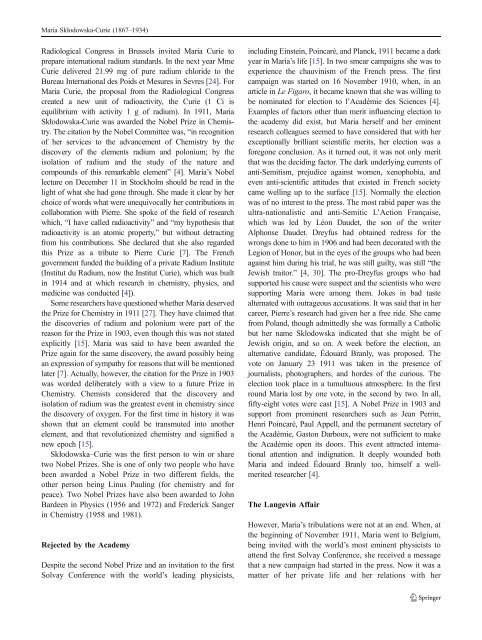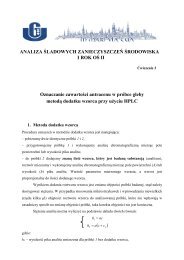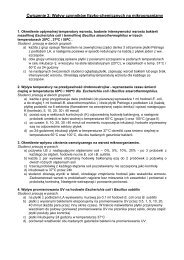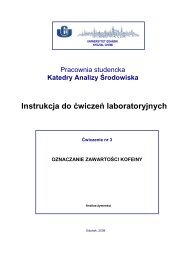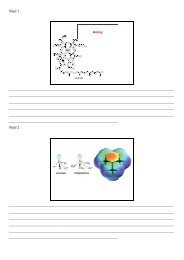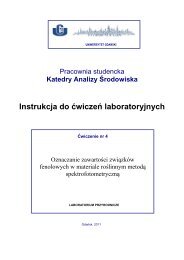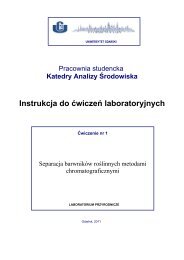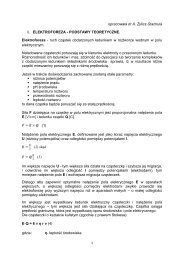Maria Skłodowska-Curie (1867–1934)—her life and discoveries
Maria Skłodowska-Curie (1867–1934)—her life and discoveries
Maria Skłodowska-Curie (1867–1934)—her life and discoveries
Create successful ePaper yourself
Turn your PDF publications into a flip-book with our unique Google optimized e-Paper software.
<strong>Maria</strong> <strong>Skłodowska</strong>-<strong>Curie</strong> (<strong>1867–1934</strong>)Radiological Congress in Brussels invited <strong>Maria</strong> <strong>Curie</strong> toprepare international radium st<strong>and</strong>ards. In the next year Mme<strong>Curie</strong> delivered 21.99 mg of pure radium chloride to theBureau International des Poids et Mesures in Sevres [24]. For<strong>Maria</strong> <strong>Curie</strong>, the proposal from the Radiological Congresscreated a new unit of radioactivity, the <strong>Curie</strong> (1 Ci isequilibrium with activity 1 g of radium). In 1911, <strong>Maria</strong><strong>Skłodowska</strong>-<strong>Curie</strong> was awarded the Nobel Prize in Chemistry.The citation by the Nobel Committee was, “in recognitionof her services to the advancement of Chemistry by thediscovery of the elements radium <strong>and</strong> polonium; by theisolation of radium <strong>and</strong> the study of the nature <strong>and</strong>compounds of this remarkable element” [4]. <strong>Maria</strong>’s Nobellecture on December 11 in Stockholm should be read in thelight of what she had gone through. She made it clear by herchoice of words what were unequivocally her contributions incollaboration with Pierre. She spoke of the field of researchwhich, “I have called radioactivity” <strong>and</strong> “my hypothesis thatradioactivity is an atomic property,” but without detractingfrom his contributions. She declared that she also regardedthis Prize as a tribute to Pierre <strong>Curie</strong> [7]. The Frenchgovernment funded the building of a private Radium Institute(Institut du Radium, now the Institut <strong>Curie</strong>), which was builtin 1914 <strong>and</strong> at which research in chemistry, physics, <strong>and</strong>medicine was conducted [4]).Some researchers have questioned whether <strong>Maria</strong> deservedthe Prize for Chemistry in 1911 [27]. They have claimed thatthe <strong>discoveries</strong> of radium <strong>and</strong> polonium were part of thereason for the Prize in 1903, even though this was not statedexplicitly [15]. <strong>Maria</strong> was said to have been awarded thePrize again for the same discovery, the award possibly beingan expression of sympathy for reasons that will be mentionedlater [7]. Actually, however, the citation for the Prize in 1903was worded deliberately with a view to a future Prize inChemistry. Chemists considered that the discovery <strong>and</strong>isolation of radium was the greatest event in chemistry sincethe discovery of oxygen. For the first time in history it wasshown that an element could be transmuted into anotherelement, <strong>and</strong> that revolutionized chemistry <strong>and</strong> signified anew epoch [15].<strong>Skłodowska</strong>–<strong>Curie</strong> was the first person to win or sharetwo Nobel Prizes. She is one of only two people who havebeen awarded a Nobel Prize in two different fields, theother person being Linus Pauling (for chemistry <strong>and</strong> forpeace). Two Nobel Prizes have also been awarded to JohnBardeen in Physics (1956 <strong>and</strong> 1972) <strong>and</strong> Frederick Sangerin Chemistry (1958 <strong>and</strong> 1981).Rejected by the AcademyDespite the second Nobel Prize <strong>and</strong> an invitation to the firstSolvay Conference with the world’s leading physicists,including Einstein, Poincaré, <strong>and</strong> Planck, 1911 became a darkyear in <strong>Maria</strong>’s<strong>life</strong>[15]. In two smear campaigns she was toexperience the chauvinism of the French press. The firstcampaign was started on 16 November 1910, when, in anarticle in Le Figaro, it became known that she was willing tobe nominated for election to l’Académie des Sciences [4].Examples of factors other than merit influencing election tothe academy did exist, but <strong>Maria</strong> herself <strong>and</strong> her eminentresearch colleagues seemed to have considered that with herexceptionally brilliant scientific merits, her election was aforegone conclusion. As it turned out, it was not only meritthat was the deciding factor. The dark underlying currents ofanti-Semitism, prejudice against women, xenophobia, <strong>and</strong>even anti-scientific attitudes that existed in French societycame welling up to the surface [15]. Normally the electionwas of no interest to the press. The most rabid paper was theultra-nationalistic <strong>and</strong> anti-Semitic L’Action Française,which was led by Léon Daudet, the son of the writerAlphonse Daudet. Dreyfus had obtained redress for thewrongs done to him in 1906 <strong>and</strong> had been decorated with theLegion of Honor, but in the eyes of the groups who had beenagainst him during his trial, he was still guilty, was still “theJewish traitor.” [4, 30]. The pro-Dreyfus groups who hadsupported his cause were suspect <strong>and</strong> the scientists who weresupporting <strong>Maria</strong> were among them. Jokes in bad tastealternated with outrageous accusations. It was said that in hercareer, Pierre’s research had given her a free ride. She camefrom Pol<strong>and</strong>, though admittedly she was formally a Catholicbut her name Sklodowska indicated that she might be ofJewish origin, <strong>and</strong> so on. A week before the election, analternative c<strong>and</strong>idate, Édouard Branly, was proposed. Thevote on January 23 1911 was taken in the presence ofjournalists, photographers, <strong>and</strong> hordes of the curious. Theelection took place in a tumultuous atmosphere. In the firstround <strong>Maria</strong> lost by one vote, in the second by two. In all,fifty-eight votes were cast [15]. A Nobel Prize in 1903 <strong>and</strong>support from prominent researchers such as Jean Perrin,Henri Poincaré, Paul Appell, <strong>and</strong> the permanent secretary ofthe Académie, Gaston Darboux, were not sufficient to makethe Académie open its doors. This event attracted internationalattention <strong>and</strong> indignation. It deeply wounded both<strong>Maria</strong> <strong>and</strong> indeed Édouard Branly too, himself a wellmeritedresearcher [4].The Langevin AffairHowever, <strong>Maria</strong>’s tribulations were not at an end. When, atthe beginning of November 1911, <strong>Maria</strong> went to Belgium,being invited with the world’s most eminent physicists toattend the first Solvay Conference, she received a messagethat a new campaign had started in the press. Now it was amatter of her private <strong>life</strong> <strong>and</strong> her relations with her


